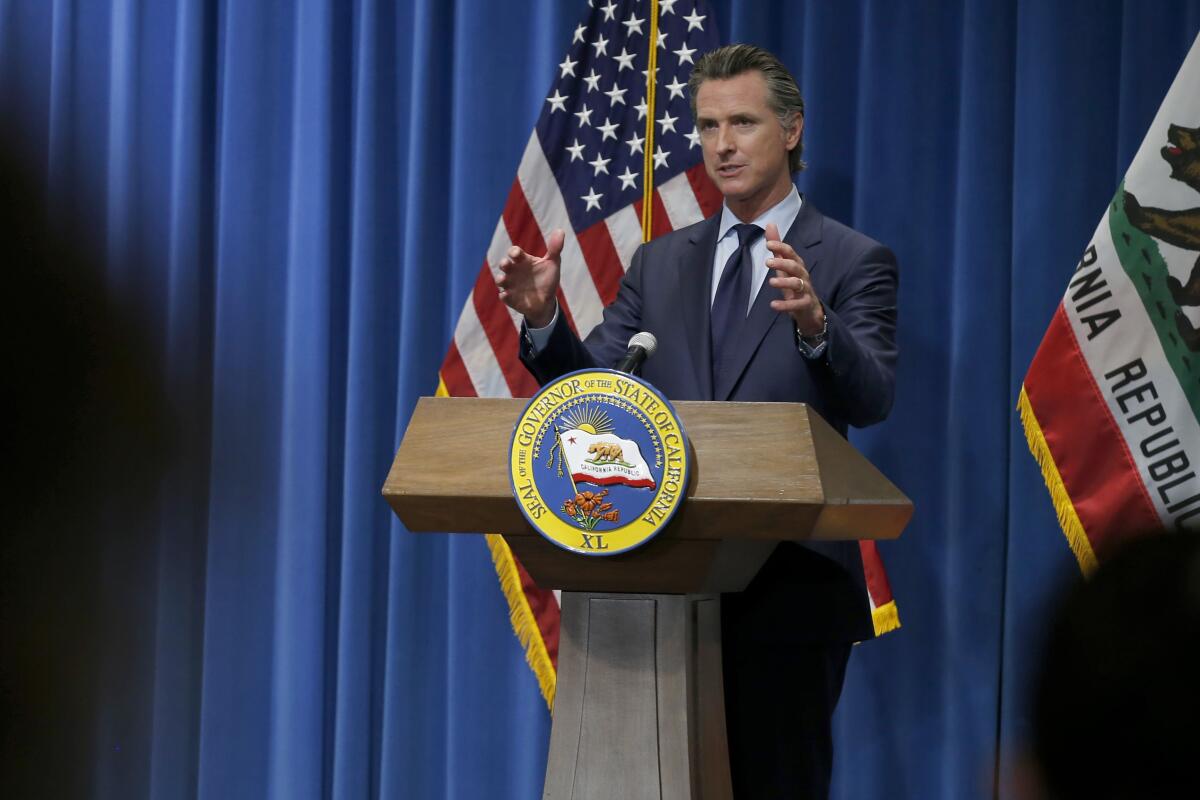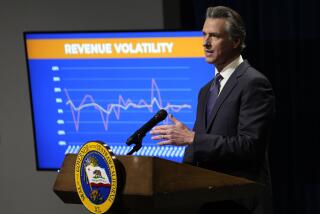Newsom agrees to rethink sharp California budget cuts in deal with lawmakers

- Share via
SACRAMENTO — Gov. Gavin Newsom agreed Monday to largely abandon the far-reaching spending reductions he proposed as necessary without new federal coronavirus relief funds, striking a budget pact with leaders of the California Legislature that relies on a mix of different cuts, along with a more optimistic economic outlook, to protect social services programs and public schools.
The compromise, announced in a brief statement released by Newsom and Democratic legislative leaders, came one week after legislators passed a placeholder budget that met a constitutional deadline, avoiding the forfeiture of their pay. Formal approval of the final budget isn’t expected until later this week.
“The COVID-19 global pandemic has caused a sudden and dramatic change in our nation’s and state’s economic outlook — and has had a cascading effect on our state budget,” the statement said. “In the face of these challenges, we have agreed on a budget that is balanced, responsible and protects core services — education, health care, social safety net and emergency preparedness and response.”
No topic was more contentious than Newsom’s original plan to cut $14 billion in spending, a downsizing only to be reversed if Congress and President Trump provide new coronavirus assistance to states in early summer. The governor’s effort would have cut spending on 89 different state programs. About $8 billion of the cuts would have come from funding for K-12 schools and community colleges.
Lawmakers flatly rejected Newsom’s cuts to schools and a wide array of social services, insisting the state should extend the deadline for new federal money until the end of September before finding an additional $14 billion in budget savings.
The final agreement, outlined for The Times by legislative sources who spoke on condition of anonymity because they aren’t authorized to discuss it publicly, relies on a hybrid of two approaches to reduce spending by $12 billion. Spending cuts linked to future federal funds will be made immediately, as Newsom had wanted. But the agreed-upon cuts largely avoid major impacts to social services programs Democratic lawmakers said are vital to the state’s most vulnerable residents. Key portions of the projected deficit would be erased by using part of the state’s historically large cash reserves. The agreement, the sources said, also assumes tax revenues will be better than expected — reducing additional cuts by about $1 billion.
An estimate provided by the Newsom administration shows the final agreement relies on solutions that will shrink the projected deficit in the fiscal year that begins in the summer of 2021 down to $5 billion; the legislative budget plan would have left a shortfall of $13.5 billion.
“This is a multiyear framework,” Newsom said on Monday during an event to discuss the state’s response to COVID-19. “We have a lot of work to do over the next few years.”
The governor and legislative leaders highlighted the budget deal’s protection of funding for K-12 schools, largely left at current service levels — a notable outcome, given the sharp decline in tax revenues and with school spending the largest part of the state’s general fund. While legislators abandoned their effort to adjust school spending for inflation, education advocates believe most districts will be able to maintain operations as they were in the prior academic year.
The budget also gives schools a one-time boost of about $5 billion from the state’s portion of the federal CARES Act, earmarked to help cover distance learning and other unexpected costs related to the COVID-19 pandemic.
Maintaining current school services won’t be easy, as the budget agreement spreads out the state’s funding for those services over several years. School districts will have to use cash reserves or borrow money to foot the bill for about $12.5 billion in expenses that the state would normally be required to cover. While similar deferrals of state education spending were used extensively during the Great Recession, the amount of delayed funding grew toward the end of private negotiations. And budget advisors say up to $6 billion of the IOUs to schools can be canceled if the federal funds materialize.
While some school districts may struggle with providing cash to be repaid later, Newsom said the budget will prohibit teacher layoffs.
“That was foundational, important, something we all care deeply about,” he said Monday.
But other proposed cuts, according to legislative sources, grew deeper in the final deal and were more in alignment with Newsom’s original budget plan. That includes $970 million less for the University of California and California State University systems, combined. Programs aiming to provide more housing for low- and middle-income Californians will be cut by $250 million. And court operations across the state will be cut by $150 million.
County governments, which have lost tax revenues during the fast-moving recession that pay for public safety and health programs, would receive $750 million to fund those services — less than the $1 billion local officials asked for during the negotiations. The remaining $250 million would only be allocated if new federal coronavirus relief arrives.
“It’s a tough budget for all of us,” Newsom said Friday during a visit to a Sacramento restaurant to promote his program for helping shut-in seniors to receive meals during the pandemic. “The magnitude of the shortfall is unprecedented in the state’s history.”
The budget agreement also includes new tax revenues. It cancels $4.4 billion in tax breaks primarily used by business tax filers, an effort roundly criticized by Republicans in the Legislature during the vote on the legislative budget this week.
Legislators set aside less money for the state’s COVID-19 response, rejecting Newsom’s plan to essentially prepay costs that should be reimbursed by the Federal Emergency Management Agency.
The budget agreement boosts some spending, adding $350 million for homelessness programs. It also expands California’s tax credit for its poorest residents to those who have only an employer identification number, not a Social Security number, often because they lack legal immigration status.
State government workers will bear some $2.8 billion of the budget cuts, with those represented by Service Employees International Union Local 1000 taking two furlough days per month and delaying until 2022 a pay increase that was supposed to go into effect July 1. A separate furlough plan was agreed to last week by the union representing correctional officers. With other groups of workers, the deal provides Newsom the power to impose some furloughs on his own.
“To be clear, this budget required some tough decisions and more work remains ahead,” the statement released by Newsom and legislative leaders said.
Marathon talks between Newsom and lawmakers ran through two consecutive weekends and late into most evenings before Monday’s announcement. In the decade since voters loosened the legislative threshold for passing a budget, the process has generally produced quick agreements between Democratic governors and legislators, though last year’s deal was delayed by disagreements over how to address the state’s housing crisis.
In reality, California has no real deadline for a final agreement — instead requiring the initial budget bill to be ratified by June 15 to prevent lawmakers from losing their pay, followed up by a series of budget-enacting bills approved on a more flexible timeline. A 2014 court ruling determined only the overview budget plan is subject to the June 15 constitutional deadline, with revisions and additional decisions allowed weeks or even months after the fiscal year begins July 1.
More to Read
Sign up for Essential California
The most important California stories and recommendations in your inbox every morning.
You may occasionally receive promotional content from the Los Angeles Times.











